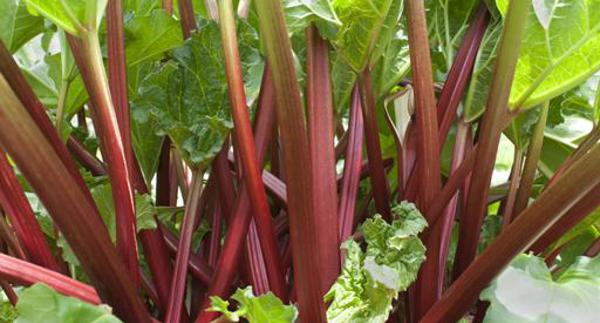
5 Steps to Rhubarb Success
- Choose a spot in full sun.
- Prepare your soil with organic matter like compost and sheep pellets.
- Add a layer of vegetable mix to plant into. Autumn through to the end of spring is generally a good time to plant rhubarb in New Zealand.
- Feed with a general fertiliser during the key growth periods of spring and autumn.
- Keep plants well watered, particularly through dry periods.
Follow our full guide below to a bumper crop of rhubarb.
Rhubarb is one of the hardier crops, tolerant of cold, frost and wind. It's a staple crop you can plant, fertilise, water and walk away from once it’s established. Aesthetically, it adds colour and texture to the garden.
Rhubarb is sometimes considered a fruit, because it is generally eaten with sweet dishes. Technically, however, it’s a vegetable, and hence it appears in vegetable patches and plots around the country.
When planting rhubarb remember that rhubarb leaves are poisonous and that only the stem can be cooked and used.
Choose a variety - top picks
- Glaskin’s Perpetual: an early variety with slim, bright red stems that is quick to establish from seed.
- Victoria: the most popular variety of rhubarb, it has a chunky, more compact habit with upright red and green stems.
- Ruby Tart: strong growing with ruby red stems and a superior taste.
- Winter Harvest: produces juicy, sweet, bright red stalks.
There are red and green varieties of rhubarb available, green stems are normal for green varieties.
Plant
Rhubarb enjoys fertile, well-drained soil in full sun and dislikes having wet feet. It doesn’t like sandy soils unless plenty of organic matter has been dug in.
Prepare the soil by digging in Tui Super Sheep Pellets and Tui Compost before planting rhubarb. Then you can add a layer of Tui Vegetable Mix.
Rhubarb is also happy growing in large pots and containers, making it an ideal portable crop. Fill pots and containers with Tui Vegetable Mix.
Directions for planting in garden beds
- Soak seedlings in a bucket of Tui Organic Seaweed Plant Tonic and allow to drain. This will help prevent transplant shock.
- Add a layer of Tui Vegetable Mix to the planting area.
- Dig a hole, approximately twice the depth and width of the root ball of your plant.
- Gently loosen the root ball of your plant and position the plant in the centre of the hole.
- Fill in with Tui Vegetable Mix.
- Press soil gently around the base of the plant.
- Water your plant well and continue to water regularly.
Rhubarb can also be grown from seed, by dividing existing clumps or purchasing a plant from the garden centre.
Plants sown from seed take a few years to establish themselves. Sow seed in trays of Tui Seed Raising Mix in spring, and transfer into pots to grow once a few sets of leaves appear. Plant out 1m apart in the garden once seedlings are at least 10cm tall and look robust.
When dividing existing clumps the quickest way is to split pieces off an existing plant in spring, autumn or winter. To do this, slice through the crown of the plant with a sharp spade or long knife. Plant the whole section in the ground or in a pot (that is bigger than the off-cut). Once the plant begins to put down roots, new leaves will appear.
Nourish
Feed your plants and they will feed you. To promote the growth of more stems, keep plants well watered through dry periods. However, don’t panic if plants get dry, as they will bounce back once watered.
Feed with a general fertiliser such as Tui General Fertiliser or Tui Blood & Bone during the key growth periods of spring and autumn. Keeping it well nourished and watered will help keep insect pests at bay.
As rhubarb like nitrogen rich soil, another way to feed your rhubarb is to place sheep pellets and water in a muslin cloth or old stocking and pour over your plants.
Harvest and storage
Pick rhubarb when the stalks are thick enough. Avoid leaving them too long as the larger stalks can sometimes taste bitter and come woody. When harvesting, firmly grasp a stalk close to the ground. Twist and pull the stalk – it should break free of the plant. Do this carefully as you don’t want to break off new shoots while you are picking your crop. If you can’t twist the stems off easily, cut them as close to the base of the plant as possible.
Rhubarb stems will store in the fridge for a week or so. They can also be frozen for up to three months once cut into 5-10cm lengths.
Tui Tips
- Keep the area around the plants weed free. Watch out for slugs and snails, which can quickly shred the lush leaves of your rhubarb. Lay Tui Quash slug & snail control to protect your plants.
- Plants will last for years with the right care. Add compost to the soil each year and keep plants well watered through dry periods. When the top growth dies back in autumn, remove the dead leaves to expose the base of the plant to the cool weather. This helps stimulate new shoots for the following season.
Information extracted from the Tui NZ Vegetable Garden Book, 3rd Edition, By Rachel Vogan.